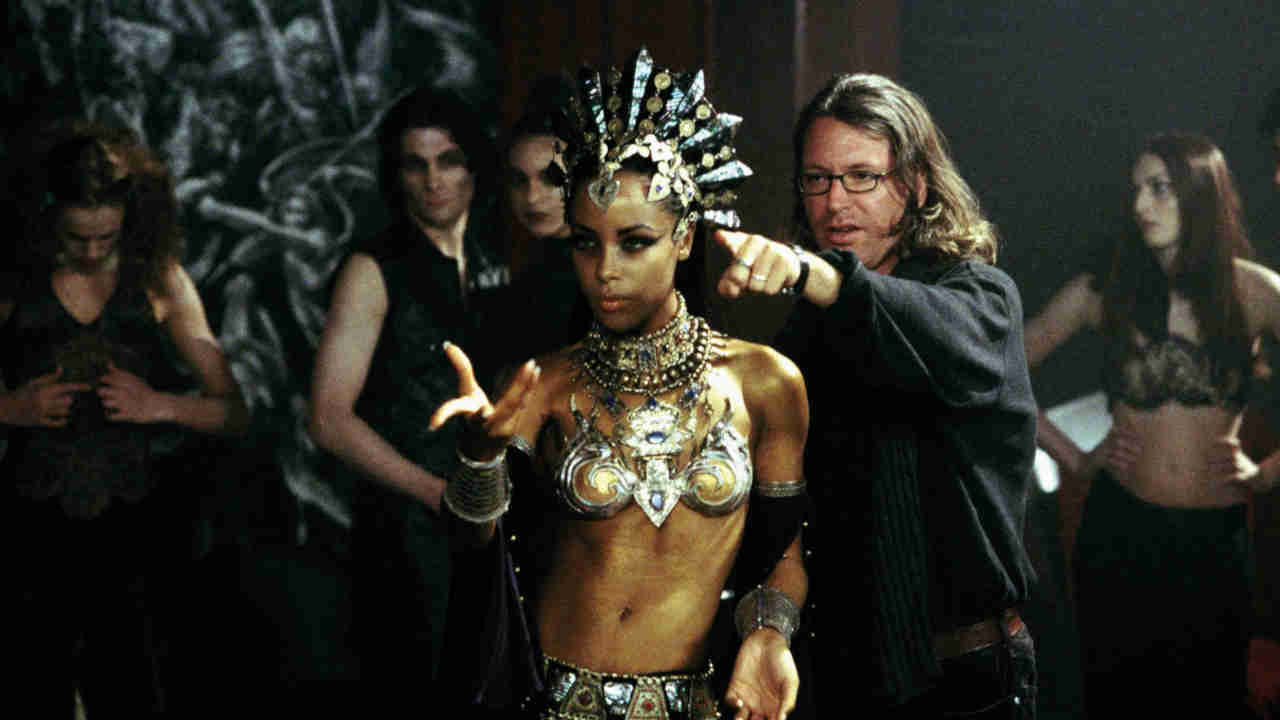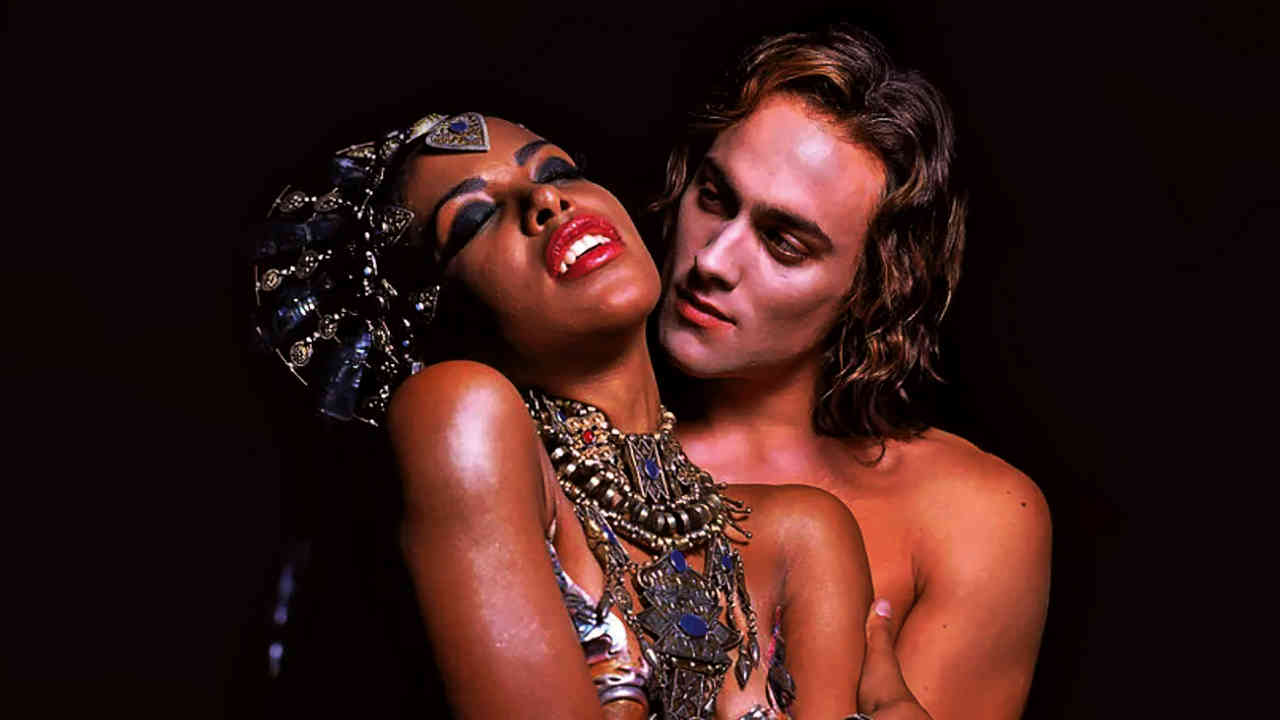One Halloween, Australian director Michael Rymer found himself surrounded by thousands of vampires. He’d signed on to direct a movie based on the second and third books of Annie Rice’s gothic fiction series, The Vampire Chronicles, and had travelled to her hometown to meet her.
“Warner Bros flew me to New Orleans and put me in a hotel, and then Anne sent an old hearse she’d converted into a clear glass limo, and took me to the monastery she’d bought,” he recalls. “It was decorated with rooms of mannequins and dolls. I stayed there, and the next day I was picked up and taken to a big, old house in the Garden District in New Orleans – maybe three, four storeys tall, with a giant, stuffed wolf looking down. And the limo door opens, and there’s this guy with slicked-back hair and a ponytail and a gun holster, and he says, in the thickest Louisiana drawl, ‘Welcome to New Orleans.’”
It was October 31, the day of Anne’s annual vampire bash. Michael ascended the stairs of the house, knocked on a door, and was greeted by a 17-year-old boy wearing a frilly shirt and angel wings. Anne, not in costume, entered the room.
“She was basically a miniature version of Diane Keaton. She had little round glasses, a hat, a long waistcoat and a long shirt – sort of San Francisco hippy chic,” remembers Michael. “And then we went to the ball, and there were about 6,000 vampires dressed in all sorts of crazy outfits. Anne came onstage and introduced me, and talked about the film. That was a pretty trippy weekend to get things rolling.”
The film was Queen Of The Damned, an adaptation of the 1988 novel of the same name and previous instalment The Vampire Lestat (1985). It would follow Neil Jordan’s sumptuous version of the first book, Interview With The Vampire, which was the 10th-highest grossing movie of 1994 in the US and landed two Oscar nominations.
The premise for Queen Of The Damned was simple: the vampire Lestat awakens and reinvents himself as a rockstar. His music wakes Akasha, the queen of the vampires, who wants to make Lestat her king. Despite the OTT gothic sets and costumes, on release in 2002 the film was largely derided by critics – but nearly everyone recognised the brilliance of its soundtrack.
Featuring original metal songs and an accompanying orchestral score by Korn frontman Jonathan Davis and film composer Richard Gibbs (Dr. Dolittle, Big Momma’s House), alongside a handful of existing nu metal dancefloor classics, it was moody, evocative and captured the zeitgeist. Upon its release, Neil Corry from Film Review magazine described Queen Of The Damned as: “A pile of nonsense, but great-looking nonsense at that with a phenomenally loud soundtrack.”
It came at a time when Hollywood was flirting with heavy music: the likes of The Matrix (1999), action-horror film Resident Evil (also released in 2002), and slasher Freddy Vs. Jason (2003) featured artists such as Rob Zombie, Rammstein, Slipknot, Lamb Of God and In Flames. In early conversations Michael had with the studio, someone proposed that Queen Of The Damned’s music should be ‘romantic’, in the vein of Echo And The Bunnymen – but Michael was worried it would come across as cheesy.
“My pitch to them was, ‘Look at the soundtrack Warner Brothers have done for Batman [& Robin],’” he says, which included The Smashing Pumpkins and Underworld. “Batman’s a pretty straightforward commercial movie, and they had very edgy needle drops on there. That worked well, and it gave films a sort of immediate edge and energy they hadn’t earned on their own.”
Enter: Jonathan Davis and Richard Gibbs, who’d already formed a partnership via Korn’s publisher, Zomba. Jonathan had expressed an interest in film composition and Richard, previously the keyboard player for offbeat musical troupe Oingo Boingo, wanted to see what the Freak On A Leash singer could do. He let Jonathan have a stab at scoring a scene for a TV movie.
“The piece of music he wrote was really, really awful! Ha ha ha! And I razzed him about it,” Richard laughs. “But it was brilliant in one way. And it was the one thing I really wanted to see: would he be able to subsume his ego, would he know how to write in support of the scene, in support of the characters, and not be a rockstar writing rock songs? And he immediately did that.”
“He wanted to see if I had the ear for it, if I could paint emotion while watching a picture,” remembers Jonathan. “So we did that, hit it off, and I was stoked – like, OK, let’s do a movie!’”
The pair unsuccessfully pitched for Jerry Bruckheimer’s heist film, Gone In 60 Seconds, but luckily Queen Of The Damned was lurking around the corner. Meeting with Michael, they stipulated that they didn’t just want to write the songs Lestat the rockstar would sing – they also wanted to write the orchestral score.
“I think the moment when I feel like we really got the job was… in the books and the movie, the vampire Lestat plays violin, and in the script, it even mentioned ‘Paganini-style violin’ – a classical violinist. And I looked at Michael and I said, ‘That’s kind of been done to death, and we can certainly do that, but I have a different pitch for you.’ And Michael said, ‘What’s that?’ And I said, ‘Well, I know this guy Shankar.’’
Indian composer and virtuoso violinist Shankar had worked with Peter Gabriel on the Grammy award-winning soundtrack for 1988’s The Last Temptation Of Christ, and draws on a range of Eastern traditions. “I started explaining who Shankar was, and I just saw Michael’s face light up. He was a huge fan.”
Getting the music right was such a priority that the only actor who’d been cast by this point was rising R’n’B star Aaliyah, as Queen Akasha. Michael had auditioned her in Vancouver, where she was shooting Romeo Must Die. “By the end of the process, I had her crawling around on the ground, rolling her Rs with an Egyptian accent, like a cat, reciting Oscar Wilde’s [one-act tragedy] Salome,” he remembers. “So that’s sort of how she got the role. She was not a star, she was someone who was a comer, and wanted to prove herself – as was I.”

Jonathan Davis relished the chance to embody the persona of Lestat, something that came naturally to the self-professed night owl. “I had to become Lestat, and I read the books, and wrote lyrics about being a fucking 400-year-old vampire, and it was so fucking fun,” he smiles.
Richard joined him on the road with Korn for a month; after each show, they would write until dawn. Once the songs were done, with Jonathan on vocals, they drafted in Limp Bizkit’s Sam Rivers on bass, Head and Munky for some guitar work, Terry Bozzio (Missing Persons) and Vinnie Colaiuta (Sting, Frank Zappa) on drums, and Shankar on violin. From the eight songs, Michael picked five ahead of production: Not Meant For Me, Forsaken, System, Redeemer and Slept So Long.
Queen Of The Damned was unique among films of the time; not only were these songs original, they were written for performance segments rather than just background music. A new band of musicians were cast in Melbourne, to mime the songs on camera, and Richard was sent to rehearse with them, to make sure they looked convincing. There was one problem: Stuart Townsend, who had been cast as Lestat over potentials such as Wes Bentley and Heath Ledger, refused to comply. At an earlier meeting, he had condemned the songs as “arena rock” and “too American”, and during practice he’d turn his back to the band. Richard didn’t even know if he knew the lyrics.
The first day the cameras rolled on Stuart, they were filming a live performance video for the song System, to be shown on a television behind the bar at The Admiral’s Arms vampire club. Stuart was late to the stage because he was arguing with the crew about wearing a blond wig, so they let him have brown hair instead. Then, he opened his mouth.
“The song starts, and that fucking guy had sandbagged us!” exclaims Richard. “He knew the songs inside out, he had clearly been rehearsing, and he looked like somewhere between Mick Jagger and Tina Turner and David Bowie, doing all the traditional rock’n’roll moves, and just blew us all away. We couldn’t believe what we just saw!”
In one of Queen Of The Damned’s most memorable moments, Lestat plays a massive concert in Death Valley, California, where Akasha shows up and immolates a bunch of vampires. The crowd were comprised of thousands of goth extras bussed to a cold, remote quarry outside Melbourne. Richard figured that real fans would know the lyrics to Lestat’s songs, so he got onstage and faked a phone call to Jonathan in order to teach the extras the words for the scene.
“I was lying through my teeth: ‘Jonathan wants to hear you guys sing the song!’ So I gave them the line from Slept So Long: ‘Did you think it’s cool to walk right up / to take my life and fuck it up.’ They were kidnapped and lied to, and underpaid, and fed crap food! But, they were amazing.”
Halfway through shooting, the cast and crew had a ‘half wrap’ party. It was here that Aaliyah revealed something surprising. “She walked up to me at the bar and said: ‘Richard, I just want to let you know, I love the songs you and Jonathan wrote.’ And you could have picked my jaw up off the floor. Really? This beautiful R’n’B pop songstress? She saw the surprise on my face and said, ‘Oh, I love Korn.’ And then she hit me with one more surprise. She said: ‘I’d love it if you and Jonathan would write a song for me.’”
During post-production, Aaliyah flew to the Bahamas to shoot a music video, and was planning to return to LA to do her automatic dialogue replacement and record a song for the end titles. Tragically, she died in a plane crash on August 25, 2001. “It’s so terribly, terribly shocking,” says Michael. “At least I got to make a film with her, and I think she’s the best thing in it.”
In tribute to Aaliyah, Richard and Jonathan are planning to finally write the song she requested, on camera, for an episode of a new series called The Woodshed Revelations, named after Richard’s Woodshed Recording Studio. “It’s a homage to her,” he says. “Jon and I were heartbroken.”
With the soundtrack completed, a proud Jonathan was dealt a blow when his label, Sony, gave permission for his voice to appear in the film but not on the OST release. “Oh, that fucking pissed me off!” he exclaims today. “I was so fucking mad, like, ‘Are you kidding me? You know how hard I worked on this, right?’”
Jonathan and Richard auditioned replacement singers – Richard remembers Elijah Blue, Cher and Gregg Allman’s son, being in the mix – but they didn’t feel right. As the film was being made by Warners, they solved the problem by recruiting guest vocalists from the label, including Orgy’s Jay Gordon and Disturbed’s David Draiman, plus two icons we’ve since sadly lost: Wayne Static and Chester Bennington. The recordings took place during two evening sessions at The Village studios in LA.
“I said to them, ‘OK, you do you, don’t try to emulate me,” remembers Jonathan. “I was right there when they did the recordings, I produced it with them, and it came out good. I mean, they’re good, but my voice sounded best, because that was the real fucking shit right there…
“Chester comes in with his wife, and he was a lovely, lovely soul,” remembers Richard. “His wife was really sweet, and she confided in me. She says, ‘You know, Chester never curses on record. This is the first time anybody’s ever recorded him cursing’, which gave Jon a certain amount of pride!”
“They all killed it,” Richard adds. “The one who was the most problematic was the guy from Orgy. Ultimately he did a good job, but it took a minute to get; his head was elsewhere.”
“Problem is, when I showed up to the studio, I had a golf ball in my throat,” remembers Jay, who shared management with Korn, had toured with them on Family Values, and sang on Slept So Long. “I had a really sore throat. I don’t know how we even got through it, but we were like, ‘We’ll go for it, we’ll try it’ – and then it all came together.”
Almost two decades later, Orgy debuted it live at the 2020 Los Angeles Vampire Ball at the Globe Theatre. “Vampires love it, apparently!” he laughs. “People would always ask me if we’d play it, and I thought, ‘Well, maybe it’s a little too slow,’ but opening up with it at the Vampire Ball seemed to be a really cool thing to do, because it’s really moody.”
Elsewhere on the soundtrack, Warners selected timeless nu metal songs. Papa Roach’s Dead Cell plays during a street scene, while Disturbed’s Down With The Sickness rings out as the camera pans over the Death Valley concert. “One of my favourites is [Deftones’] Change (In The House Of Flies) on the lovemaking scene,” says Michael, referring to the part where Akasha and Lestat are in a bath scattered with rose petals – a teenage goth’s dream.
The film was released in February 2002 in the USA and April in the UK, but for all its dark imagery and rockstar glamour, it was not well received. On Rotten Tomatoes, it sits at 17% on the Tomatometer, with a 66% Audience Score. Michael agrees with the assessment. “There are many wonderful things about it, but as a horror movie, as an execution of a famous novel that people love, it was not a success,” he concedes. “Anne Rice was polite, but she was horrified when I showed it to her! We were cramming two books into one movie.”
He’s most proud of the soundtrack, which went gold, selling half a million copies in a year. For Jonathan, it was a leap outside his comfort zone that paid off. Did it give him more confidence in his abilities? “It totally did. It gave me the confidence to reach out and start doing more,” he says. “My solo record, [2018’s] Black Labyrinth, is in that slot too. That’s just what I write; I write dark, vampiric music.”
For Richard, too, the soundtrack remains a high point. Like the vampires in the movie, the songs are immortal. “It’s one of those touchstones in my career. If I see somebody of a certain age or in a certain context, I know that Queen Of The Damned touched them,” he says. “That soundtrack album sold very well and I’m proud of it. I think it aged well; it doesn’t sound dated to me.”

